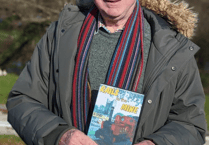Photographer Ray Roberts finds much of interest in the hedgerows aside from the flowers during a local nature walk....Walking down towards Trehunist I saw movement on the hedge and there, bathed in sunlight, was a beautiful male pheasant. He looked at me whilst I took a photo of him and then he made a very untidy take-off whilst calling kok-kok-kok-kok. I couldn’t help thinking that it must be very easy to shoot a pheasant as their lift-off speed, whilst getting airborne, is very slow and untidy making them simple to shoot and blow to smithereens.
Further on down the narrow road I saw a buzzard sitting on the top of a telegraph pole. Obviously seeking a rabbit or bird that would provide a meal as he moved his head from side to side looking along the inside of the hedgerow. When I drew close it swooped down and flew up the road between the hedges. I continued walking and there it was sitting on top of some hazel branches on the hedge and then he took off again and continued up the road on the lookout for road kill. Eventually I caught up with him only to see him fly back to the post where I’d first spotted him.
It just shows that there is always something interesting on the hedgerows, as well as primroses and snowdrops, at this cold, wet time of the year. I came across a small holly bush growing among the leaf litter on the bottom of a hedge beside a path. It had both green and yellow leaves and it looked really beautiful. However, growing where it was, I think the chances of this bush getting bigger and stronger are very slim.
A lovely sight greeted me when I got to Trehunist, there in someone’s front garden right beside the road were a group of mauve coloured crocuses. I think it’s great that people plant their garden flowers in a place where everyone can see them.
I was lucky enough to spot some yellow flowers on the yew tree down in the graveyard. This is a first time I have noticed flowers on this tree in the eight years that I have lived in the village and they stood out against the narrow dark green leaves. According to legend, the yew sheltered the first missionaries to Britain and so they were planted near churches as a symbol of faith.
Scarlet elf cup fungus must be one of the easiest fungi to spot as their red colour stands out well against dried leaf litter on stoney ground where they grow on dead, buried wood. Their season is late autumn, through winter to spring and are so named, according to folk lore, because elves and fairies would drink early morning dew from them and even bathe in the larger ones.
When I can get down to the woods beside Callington Newbridge car park, where this fungus grows in profusion, I will make a point of visiting very early in the morning, and hopefully, be able to see either an elf or a small fairy making the most of a scarlet elf cup full of dew.




